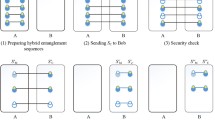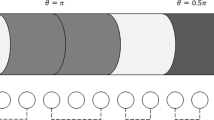Abstract
Physical layer security is one of the promising techniques for the security of next-generation wireless systems. In this paper, we analyze the impact of the limited feedback link on the secrecy capacity for a system which includes a base station with multiple antennas, a single legitimate user selected from multiple active ones and multiple eavesdroppers. We propose to design a limited feedback link by reducing the feedback load and quantizing the channel state information (CSI) of legitimate users to establish a secure communication system. The feedback load is decreased with a self discrimination criterion at the legitimate users’ side while keeping the secrecy capacity constant. The best legitimate user is selected based on the quantized CSI through a limited feedback link. We also analyze the impact of CSI of eavesdroppers, which information may or may not be available at transmitter. In practical cases where eavesdroppers are passive and their location is not known by the transmitter, an artificial noise is used to disrupt their reception. When the CSI of eavesdroppers is known, the generalized singular value decomposition is applied. We illustrate the performance results of the proposed limited feedback link through the availability of CSI of eavesdroppers at the transmitter.







Similar content being viewed by others
References
Wyner AD (1975) The wire-tap channel. Bell Syst Techn J 54(8):1355–1387
Csiszar I, Korner J (1978) Broadcast channels with confidential messages. IEEE Trans Inf Theory 24 (3):339–348
Leung-Yan-Cheong S, Hellman M (1978) The Gaussian wire-tap channel. IEEE Trans Inf Theory 24 (4):451–456
Gopala PK, Lai L, El Gamal H (2008) On the secrecy capacity of fading channels. IEEE Trans Inf Theory 54(10):4687–4698
Liang Y, Poor HV, Shamai S (2008) Secure communication over fading channels. IEEE Trans Inf Theory 54(6):2470–2492
Khisti A, Tchamkerten A, Wornell GW (2008) Secure broadcasting over fading channels. IEEE transactions on information theory 54(6):2453–2469
Parada P, Blahut R Secrecy capacity of SIMO and slow fading channels. Proceedings. International Symposium on Information Theory, 2005. ISIT 2005. Adelaide, SA, 2005, pp
Li Z, Trappe W, Yates R (2007) Secret Communication via Multi-antenna Transmission, 2007 41st Annual Conference on Information Sciences and Systems, Baltimore, pp 905–910
Shafiee S, Ulukus S (2007) Achievable Rates in Gaussian MISO Channels with Secrecy Constraints, 2007 IEEE International Symposium on Information Theory, Nice, pp 2466–2470
Khisti A, Wornell GW (2010) Secure transmission with multiple antennas I: The MISOME wiretap channel. IEEE Trans Inf Theory 56(7):3088–3104
Lai L, El Gamal H (2008) The relay–eavesdropper channel: Cooperation for secrecy. IEEE Trans Inf Theory 54(9):4005–4019
Dong L, Han Z, Petropulu AP, Poor HV (2010) Improving wireless physical layer security via cooperating relays. IEEE Trans Signal Process 58(3):1875–1888
Chen X, Yin R (2013) Performance analysis for physical layer security in multi-antenna downlink networks with limited CSI Feedback. IEEE Wirel Commun Lett 2(5):503–506
Geraci G, Couillet R, Yuan J, Debbah M, Collings IB (2013) Secrecy sum-rates with regularized channel inversion precoding under imperfect CSI at the transmitter, 2013 IEEE International Conference on Acoustics, Speech and Signal Processing, Vancouver, pp 2896–2900
Li N, Tao X, Xu J (2014) Ergodic Secrecy Sum-Rate for Downlink Multiuser MIMO Systems With Limited CSI Feedback. IEEE Commun Lett 18(6):969–972
Negi R, Goel S (2005) Secret communication using artificial noise, VTC-2005-Fall. 2005 IEEE 62nd Vehicular Technology Conference, pp 1906–1910
Goel S, Negi R (2008) Guaranteeing secrecy using artificial noise. IEEE Trans Wirel Commun 7(6):2180–2189
Lin SC, Chang TH, Liang YL, Hong YWP, Chi CY (2011) On the impact of quantized channel feedback in guaranteeing secrecy with artificial noise: the noise leakage problem. IEEE Trans Wirel Commun 10 (3):901–915
Ozdogan O, Ozbek B, Kurt GK (2016) Performance of secure multiuser MISO systems with threshold based user selection, 2016 24th Signal Processing and Communication Application Conference (SIU), Zonguldak, pp 721–724
Li N, Tao X, Wu H, Xu J, Cui Q (2016) Large-system analysis of artificial-noise-assisted communication in the multiuser downlink: Ergodic secrecy sum rate and optimal power allocation. IEEE Trans Veh Technol 65 (9):7036–7050
Deng H, Wang HM, Liu C, Wang W (2015) Performance Analysis of Linear Precoding for Secure Multiuser MIMO Systems with a Multiple-Antenna Eavesdropper, 2015 IEEE Global Communications Conference (GLOBECOM), San Diego, pp 1–6
Mo R, Yuen C, Zhang J, Chen X (2016) Beamforming design for secure downlink transmission of MU-MIMO systems with multi-antenna eavesdropper, 2016 IEEE International Conference on Communications (ICC), Kuala Lumpur, pp 1–6
Yang N, Elkashlan M, Duong TQ, Yuan J, Malaney R (2016) Optimal Transmission With Artificial Noise in MISOME Wiretap Channels. IEEE Trans Veh Technol 65(4):2170–2181
Gesbert D, Alouini MS (2004) How much feedback is multi-user diversity really worth?. 2004 IEEE International Conference on Communications, Paris, pp 234–238
Sharif M, Hassibi B (2005) On the capacity of MIMO broadcast channels with partial side information. IEEE Trans Inf Theory 51(2):506–522
Huang K, Heath RW Jr., Andrews JG (2007) SDMA with a sum feedback rate constraint. IEEE Transactions on Signal Processing 55:3879–3891
Jindal N (2005) MIMO broadcast channels with finite rate feedback, GLOBECOM ’05. IEEE Global Telecommunications Conference, pp 5
Acknowledgements
This work has been carried out in the framework of TUBITAK 114E626 Project.
Author information
Authors and Affiliations
Corresponding author
Rights and permissions
About this article
Cite this article
Özbek, B., Özdoğan Şenol, Ö. & Karabulut Kurt, G. Secure multiuser MISO communication systems with limited feedback link. Ann. Telecommun. 73, 381–390 (2018). https://doi.org/10.1007/s12243-018-0627-6
Received:
Accepted:
Published:
Issue Date:
DOI: https://doi.org/10.1007/s12243-018-0627-6




